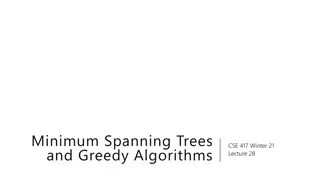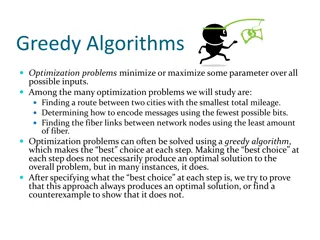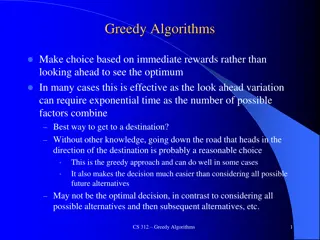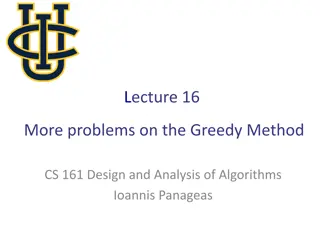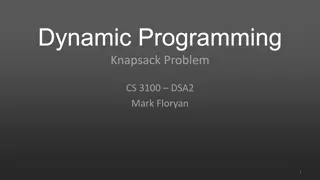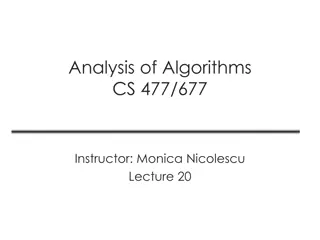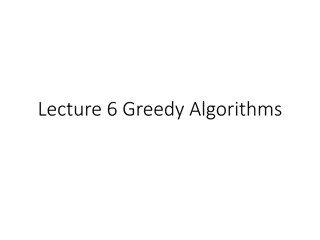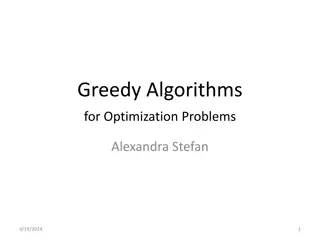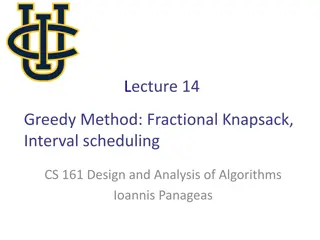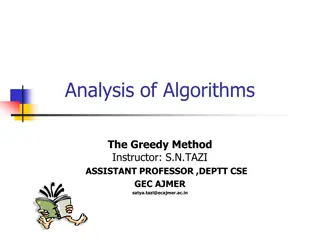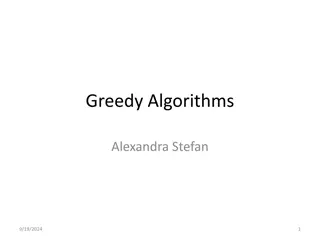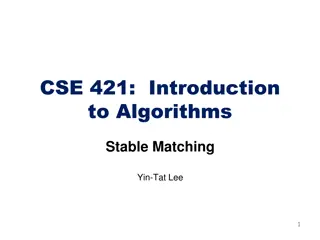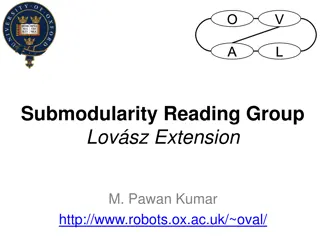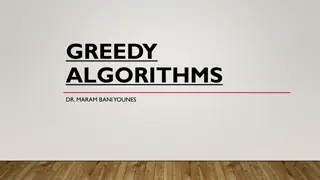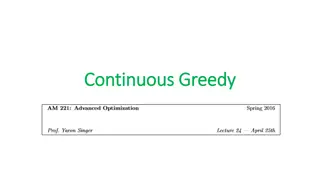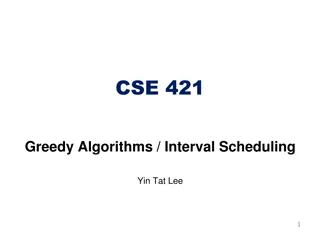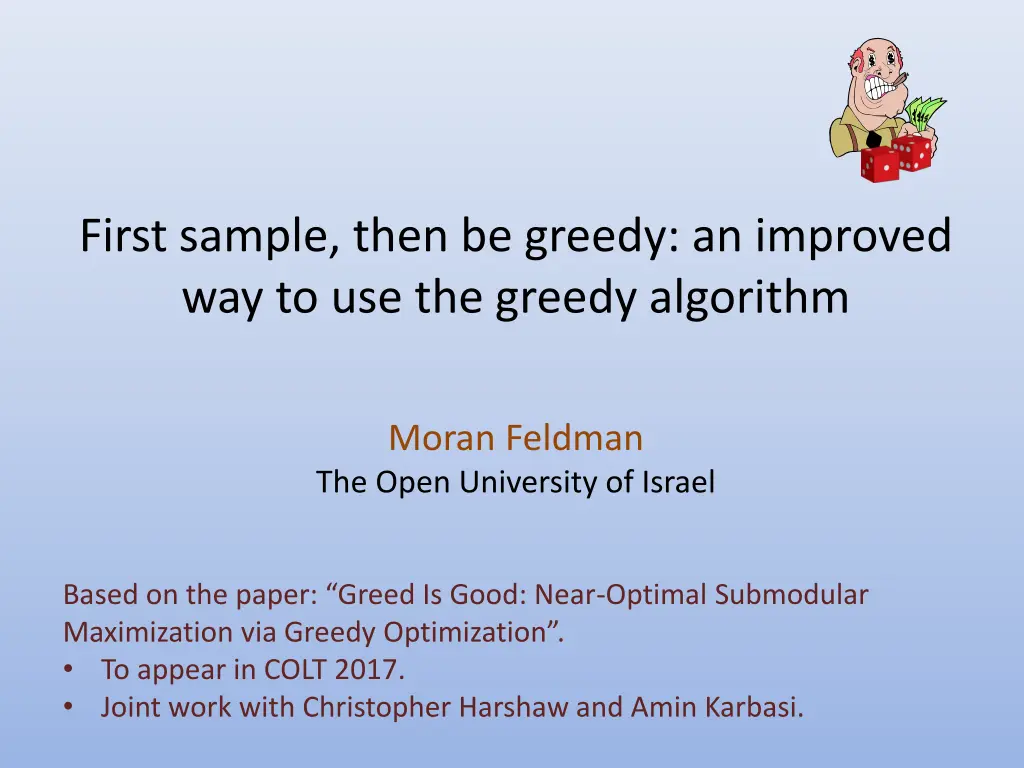
Improved Utilization of Greedy Algorithm for Optimization
Explore the enhanced application of the greedy algorithm in optimization problems, focusing on submodular maximization. Understand the theoretical foundations and practical implications through insightful examples.
Uploaded on | 0 Views
Download Presentation

Please find below an Image/Link to download the presentation.
The content on the website is provided AS IS for your information and personal use only. It may not be sold, licensed, or shared on other websites without obtaining consent from the author. If you encounter any issues during the download, it is possible that the publisher has removed the file from their server.
You are allowed to download the files provided on this website for personal or commercial use, subject to the condition that they are used lawfully. All files are the property of their respective owners.
The content on the website is provided AS IS for your information and personal use only. It may not be sold, licensed, or shared on other websites without obtaining consent from the author.
E N D
Presentation Transcript
First sample, then be greedy: an improved way to use the greedy algorithm Moran Feldman The Open University of Israel Based on the paper: Greed Is Good: Near-Optimal Submodular Maximization via Greedy Optimization . To appear in COLT 2017. Joint work with Christopher Harshaw and Amin Karbasi.
Problems of Interest max f(S) s.t. S N S obeys a constraint C Given a ground set N. The greedy algorithm is often used for such problems in practice. The size of S must be at most k. S must be a legal matching. The Greedy Algorithm While there are more elements that can be added to the solution, pick the element among them whose addition to the solution increases the value by the most, and add it. 2
Why does it Work? Theoretical results show that the greedy algorithm guarantees a good approximation ratio when: and a feasible set S, to make S + e feasible we need to remove up to k elements of S. Examples: Matroid constraint Matching constraint Any intersection of such constraints Intuitively, means that given an element e The objective function is submodular. The constraint belongs to one of a few general families of constraints. A general family of functions generalizing linear functions. Will be discussed more in a minute Here we consider a family named: k-extendible systems . 3
Submodular Functions Intuition A function is submodular if it captures the concept of diminishing returns: Adding an element to a small set increase the objective by more compared to adding this element to a large set. Definition A set function f: 2N is submodular if: f(A + u) f(A) f(B + u) f(B) f(A) + f(B) f(A B) + f(A B) A B N, u B or A, B N . Submodular functions can be found in: Combinatorics (2 examples soon) Algorithmic Game Theory Image Processing Machine Learning 4
Example 1: Cut Function A directed graph G = (V, E) with capacities ce 0 on the arcs. For every S V: Observation: f(S) is a non-negative submodular function. ( ) S = f uc v , u S v S f(S) = 3 5
Example 2: Coverage Function Elements E = {e1, e2, , en} and sets s1, s2, , sm E. For every S = {si1, si2, , sik}: Observation: f(S) is a non-negative monotone submodular function. ( ) S = f s i s S i S2 S3 Adding elements can only increase the values of sets. For sets A B N, f(A) f(B). S1 S4 S5 6
[Fisher et al. (1978), Jenkyns (1976)] Known Results If f is a non-negative monotone submodular function. C is a k-extendible system Then Then, the greedy algorithm is a (k + 1)-approximation algorithm for the problem max f(S) s.t. S N S obeys a constraint C Remark If f is linear, the approximation ratio improves to k. 7
Our Contribution Our algorithm 1. Create a sample set S containing every element of N with probability p, independently. 2. Run the greedy algorithm on S (instead of on N). If p = 1/k or p = 1/(k + 1), there is no loss in the approximation ratio, just a speed up. What do we get? Runs faster than the greedy algorithm. Approximation ratio: For non-negative montone submodular functions: max{k + 1, 1/p} For linear functions: max{k, 1/p} Another advantage will be described later 8
Greedy Analysis Idea The presentation of the analysis assumes a linear function. For every iteration of the greedy algorithm, we are interested in two entities: What we can potentially get. The gain of the iteration is the increase in the value of the solution during that iteration. The damage of the iteration is the decrease, during the iteration, in the difference between: The value of the solution. The maximum value of a feasible set containing the solution. If c Gain Damage, then the approximation ratio is at most c. 9
Greedy Analysis Idea (cont.) Greedy picks correctly It picks an element from the (current) optimal solution. No change in the value of the optimal solution. Both are equal to the change in the value of the solution. Greedy picks incorrectly It picks an element outside of the (current) optimal solution. At most k other elements have to be removed from the optimal solution. The removed elements are less valuable than the added one. Not balanced! Change in OPT k k 10
How does the Sampling Comes in? An alternative view on our algorithm Run greedy. When greedy tries to select an element: With probability p, select it. Otherwise, remove it from the instance. Observation Iterations in which the element is added behave like in standard greedy. Big question: what happens in iterations in which the element is removed? 11
Analyzing Non-selecting Iterations The solution does not change: 0 Greedy picks correctly The dismissal removes an element from the current optimal solution. Let e denote the element greedy tries to select. Greedy picks incorrectly The dismissal does not change the current optimal solution. 0 f(e) 12
Summing It All Up Greedy picks correctly Greedy picks incorrectly Selecting iteration (probability p) k f(e) In both cases max{k, 1/p} 0 Non-selecting iteration (probability 1 p) f(e) 0 p f(e) k Expectation f(e) 13
Result for Non-monotone Functions For non-negative (non-monotone) submodular functions: The greedy algorithm has no theoretical guarantee, even in the absence of a constraint. S v S Intuitively, the algorithm works ( ) S v = = = , , , because no single bad element can be selected with high probability. , and 2 N v u u u f S 1 2 n 0 otherwise Our algorithm (sampling + greedy) works for this case as well. For an appropriate choice of the parameter p, it achieves an approximation ratio of k + 2 + 1/k. 14
Experiment 15

